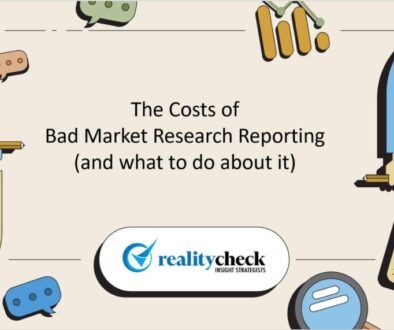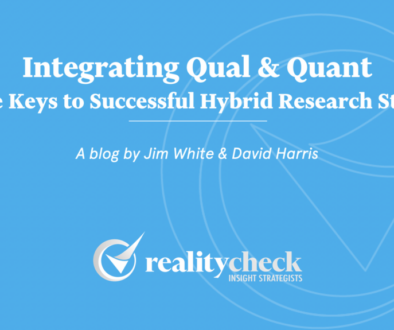What Consumer Insights Can Learn from the New Age of Journalism
There’s some pretty exciting stuff happening in the world of journalism these days and we in the consumer insights business should take note.
A lot has changed in journalism since I worked as a newspaper reporter in the ‘90s. The industry still struggles to remake itself for the digital age. It faces challenges in its economic model, competition from social media, an erosion of trust among many segments of the public, and a hyper-polarized political environment.
Spurred by this changing landscape, news organizations have evolved. And some are doing pretty interesting things. New outlets like Axios, Politico, FiveThirtyEight and Vox, and transformed old-guard institutions like the Wall Street Journal and New York Times, are leading the way in reshaping journalism for a new age.
And much of what they do can be applied to consumer insights.
After all, journalists and market researchers are in similar businesses. Like us, the job of journalists is to uncover the new information that matters most to their audiences and report it in compelling ways.
So here are four areas where consumer insights folks can learn a thing or two from the new age of journalism.
1 – Reporting what matters most
We can learn a lot from journalists about storytelling. Journalists are experts in a particular kind of story structure. Often referred to as the “inverted pyramid” style of writing, journalistic narratives start with the most important, new information. In a sense, journalists lead with their conclusions. They do this because they know if they don’t hook the reader with the most important, “new news” immediately, they’ll lose them.
Fleeting attention spans are even more of an issue in today’s news environment. The best digital news sources are masters at simplicity, clarity and prioritization. That’s why Axios promises to “get you smarter, faster with the news and information that matters,” and Vox is all about “breaking down complicated information into clear, concise explainers.”
Even though consumer insights folks talk a lot about storytelling, very few are any good at it. Most research reports are data dumps. Strategic conclusions, if reported at all, come at the end. Audiences are forced to wade through a bunch of information they already know to get to the new insights that matter most.
The Takeaway: The new insight that matters most to your audience should be the first slide, first paragraph, first sentence of your report. Lead with your conclusion. Then build a tight, concise story to support that insight. Everything else – all the stuff your audience already knows – should go in the appendix.
2 – Leveraging multiple platforms
The age of the physical newspaper and nightly newscast is gone. These days, news organizations deliver stories through a variety of platforms that provide exciting new ways for people to access the news. Regardless of whether they emerged from the print, television or digital worlds, all relevant news outlets produce podcasts, video stories, apps, websites and provide a steady stream of information through social media. They accommodate the various ways their audiences access information.
We in the consumer insights biz, on the other hand, are still wedded to PowerPoint. While video deliverables, infographics and dashboards have made some inroads, for the most part, slide decks are our stock-in-trade. I get it. PowerPoint is flexible and widely accepted. But it may be the worst storytelling medium around.
The Takeaway: Pay attention to how your audiences prefer to get information and report through platforms that accommodate them. Video, podcast-style audio reports, magazine-style articles, data visualizations and dashboards offer new possibilities for sharing insights that, in almost every case, engage and inspire audiences more effectively than PowerPoint decks.
3 – Being agile (and interesting)
Journalists are the original agile researchers. The pressure to deliver timely content has only increased in the digital age. Journalists must now “feed the monster,” as they call it, every minute. Deadlines are continuous.
They must balance the pressure to pump out content with the need to still be interesting and relevant to their audiences.
So how do they report and write with agility but still keep it interesting? First, they begin with the end in mind. Journalists set out to “get the story.” That simple phrase means they frame everything they do in terms of the end deliverable. Throughout reporting, they’re thinking about what their lead will be and the “data” they need to substantiate that lead and fill “holes” in their narrative.
Second, they operate with consistent frameworks in mind. Hard news stories, which are the ones reported on tight deadlines, follow the same structure and logic every time. Journalists don’t reinvent the narrative wheel with every story they write. They are not in the business of creative writing. They are in the business of reporting what matters most to the audience with speed, accuracy and concision. While good journalists are excellent writers, they adhere to simple story frameworks that they repeat every day. This allows them to “crank out” copy quickly, focusing on what they are communicating, rather than how to communicate it.
The Takeaway: Be thinking about your final deliverable, the story of your insights, from the get-go. Like journalists, focus your efforts on uncovering and reporting the new information that matters most. Too often, we treat study design and fieldwork as a separate endeavor from analysis and reporting. But beginning with the end in mind means setting out from the beginning, like journalists, to get the story.
4 – Visualizing data
Data Journalism has become a field unto itself. And most major news organizations now employ data analysts and dataviz designers whose job it is to tell stories with data. The Upshot, by the New York Times, leads the way in journalistic dataviz, in my opinion. Other outlets, like Nate Silver’s FiveThirtyEight, are masters at it as well. Good data journalists are experts at taking complex data sets and turning them into sticky visualizations.
Data journalists apply the same rules to dataviz that their newswriting colleagues apply to the news columns – simple, clear and engaging communication of the information that matters most.
Good data journalism contrasts with the overwrought tables and charts that appear in many market research decks. Rather than strive for simplicity and clarity, many market researchers seem bent on tonnage – beating audiences into submission and obscuring the story with slide after slide of dense statistical noise.
The Takeaway: Become a passionate student of data journalism. Most of the real-world creativity in dataviz is happening in data journalism these days. Keep your radar up for examples of great dataviz in the news. Bookmark these examples. Share them with your teams. And strive to tell stories with data the way journalists do.
At RealityCheck, we incorporate these lessons from the new age of journalism into our work every day and I suggest you do too. Focus your efforts on uncovering and reporting the “new news” that matters most to your audiences. Be fast but accurate. Connect with them in ways that go beyond PowerPoint. And learn to tell stories with data like data journalists do.
As always, let us know what you think. What else do modern journalists do that can inform the craft of insights? What fields other than journalism can consumer insights professionals learn from?
























